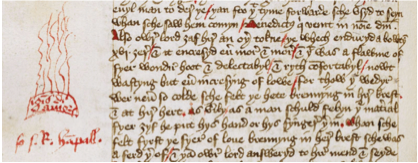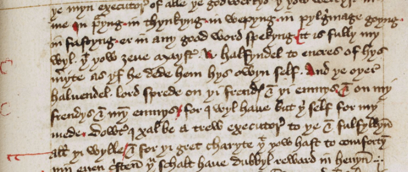fig. 1 Add. MS 61823, f. 43v. Reproduced with the permission of the British Library.
The Book of Margery Kempe records the history of critical attitudes to female piety and devotional practice as much as the life and revelations of a fifteenth-century vowess. Since the rediscovery of the “Salthouse” text in 1934 (London, British Library, Additional MS 61823, produced c. 1440), Margery’s status as a bona fide holy woman and the quality of her mystical experience have been either disparaged or defended by successive generations of scholars. Despite decades of reclamation of her narrative by progressive scholars, the perception of her as a ‘hysteric’ and ‘neurotic’ madwoman (reminiscent of Victorian attitudes to troublesome women) persists in some academic circles, and both parties often ground their arguments on critical theory published five hundred years after the Book itself.
In the Salthouse manuscript, owned by the Charterhouse of Mount Grace in Yorkshire, we find irrefutable evidence that Margery Kempe was held as a genuine spiritual authority by at least one group of contemporary readers and, moreover, that she could even have been publicly recommended as such. Being as they are contemporary affirmations of Margery’s holiness, the manuscript is another nail in the coffin for Margery’s detractors.
The most well known feature of the MS is its annotations, the work of several different hands. Unrestricted to individual words or nota-signs, they appear in Latin and English, and include entire phrases, line drawings, and even partial translations, although none exceeds twenty-one words. The sheer amount of notae (so many, in fact, that Meech declined to print them all in the Early English Text Society edition of the Book) bears witness to just how much these readers considered Margery’s experiences significant and (dare I say it?) relatively traditional. For example, the names of figures of spiritual importance are noted in the margin beside references to their works, authenticating Margery’s revelations through comparisons to “canonical” holy men and women (figs 1 & 2) by two different annotators, known as Red Ink and Black Ink.
fig. 2 Add. MS 61823, f. 19v. Reproduced with the permission of the British Library.
In figure 1 Margery’s first experience of ‘þe fyer of loue’ (88/32) is boldly noted with a stylised drawing of flames, and a Latin gloss: ‘ignis diuini amoris … so s[eint] {or scilicet?} R[ichard] [of] Hampall’. In figure 2, the Black Ink annotator corrects MS ‘pridis’ to ‘Brigyttis’, and the Red Ink annotator’s caret mark cites ‘[Richard] R[olle] [of] Hampall’ as the author of Incendium Amoris. Note the addition of punctuation to rhetorically emphasise the list’s significance: the insertion of punctus separates the individual works listed in the text, and the full colon (top line) prescribes a longer and more emphatic pause to introduce the list.
The Red Ink annotator, however, goes a step farther in making Margery Kempe relatable to his monastic readers. Where he observes similarities between Margery’s behaviour and that of two former priors of Mount Grace, Richard Methley and John Norton, he clearly indicates them in the margin (figs 3 & 4).
fig 3. Add. MS 61823, f. 33v. Reproduced with the permission of the British Library.
In fig. 3, the text reads: ‘sche had hem [fits of crying] so oftyn tymes . þat þei mayde hir ryth weyke in hir bodyly myghtys . & namely yf sche herd of owyr Lordys Passyon.’ The note reads: ‘so fa[ther] R. M. & f[ather] Norton of wakenes & of þe Passyon’.
fig. 4 Add. MS 61823, f. 85r. Reproduced with the permission of the British Library.
In fig. 4, the text reads: ‘& whan sche beheld þis sygth in hir sowle / sche fel down in þe feld a mong þe pepil / sche cryid sche roryd sche wept as þow sche xulde a brostyn þerwyth’. The note reads: ‘father M. was wont so to doo’.
The Latin annotations are significant given the context of its ecclesiastical and educational authority, which the annotators deliberately engage with in order to verify Margery’s sanctity. Red Ink emphasises that Margery is ‘singularis Christi amatrix’ (52, n. 8) [the especial lover of Christ] and reiterates that her gift of compulsive bawling is not hysteria but emulates Mary’s grief at the Passion: ‘racio hic ponitur quare sic plorans clamauit’ (190, n. 4) [This is the reason why she roared, crying, like this]. When the Book itself records Margery’s success under ecclesiastical scrutiny, this, too, is noted: the examination of her faith at the Church of All Hallows is glossed ‘examinacio dura’ [a tough interrogation] (115, n.2), and the challenge of the clerk at York who asks her to explain Genesis 1:28, Crescite et multiplicamini, is glossed ‘questio’ (sic, for quaestio), a formal theological debate. Like many of Margery’s spiritual advisors in the Book, Red Ink claims that her tears are not madness or hysteria, but the working of the Holy Spirit: ‘Non est in hominis potestate prohibere spiritum sanctum’, (149, n. 3) [It is not in man’s power to deny the Holy Spirit], he warns, when she protests to irritated parishioners that she cannot control her outbursts of weeping. He even condemns the clerks at York who would ‘not suffyr hir to dwellyn a-mong [þem], for þe pepil hath gret feyth in hir dalyawnce, and perauentur sche myth peruertyn summe of hem’ (125/14-16): ‘O ceci clerici’ (125, n.2) [O, blind clerics!] (A warning to the target audience?). Latin caecus has connotations of allegorical darkness, as well as describing someone literally sightless. To deny Margery’s holiness is to deny the working of God.
Other annotations highlight aspects of Margery’s behaviour as exempla that the reader (or listener) would do well to emulate. The original text is punctuated quite sparsely, primarily using punctus, an occasional punctus elevatus, and a more elaborated symbol to close a chapter. Red Ink added regular and consistent punctus and virgules, rubricated particular capital letters within the text (perhaps indicating sub-sections), paraph markers, and the occasional colon. This extra punctuation helps to parse the text for reading aloud.
fig. 5 Add. MS 61823, f. 11r. Reproduced with the permission of the British Library.
In this passage in fig.5, Margery is promising Christ to honour him ‘In prayng . in thynkyng . in wepyng . in pylgrimage goyng . in fastyng . er in any good word spekyng’. Note the added punctus to separate and emphasise the elements of this list as recommendations to listeners. Observe also the rubricated capital letters as subdivisions, lection markers in the margin, and the use of the bracket to break off the recitation where her speech continues, asking for a specific gift for her spiritual advisor.
An instructional context is suggested by both the alterations to punctuation and the insertion of lection markers, indicating that the Book was considered suitable for reading aloud either in Chapter or at meals. (Because monastic reading was delivered in Latin, the Latin notae could have accompanied an extempore translation of the text.) In this functional context, the notae take on a new light: as the context of the Rule of St. Benedict, Chapter 38 (on reading in the refectory), states:
[Let nobody] at table presume to ask questions about the reading or anything else … except the Superior, who may perhaps want to say something briefly for the purpose of edification.
Given that many of the glosses to the Book are of this edifying nature, such as ‘nota eius dubitacionem’ (144, n. 6) [note her doubt] beside the passage in which Margery ‘ʒ[af] no credens to þe cownsel of God but raþar leuyd it was sum euyl spirit for to deceuyn hir’ (144/23-25), Margery appears presentated as an imitable spiritual model to Carthusian monks with very little alteration to the substance of her text.
This is not to claim that the text is uncorrected. However, bearing in mind that Margery composed her Book via dictation to an amanuensis, they ought to be considered corrections of Salthouse’s text, rather than Margery’s revelations. The emendations usually alter dialectal forms (e.g. ‘gan’ à ‘began’) or obvious scribal errors (e.g. dittography). The significance of the institutional context in which the MS was annotated should also not be overlooked. The production, correction, and reading of holy books were central to the Carthusian order—not exclusively concerned with grammatical pedantry, but with enabling devotional texts to function:
Since books are like everlasting food for our souls, let them be looked after most carefully, and let us desire to do this most assiduously, so that, when we are unable to pray [aloud], we can preach the word of God with our hands. For the number of books we write seems to us as an equal number of heralds of the truth, hoping for God’s mercy for everyone who, through them, either amended their defaults, or professed the true Catholic faith, and thereby either felt compunction for their sins and vices, or kindled their desire for the heavenly kingdom. (Consuetudines, PL 153:694-695)
Through being annotated and glossed, The Book of Margery Kempe becomes one of many ‘heralds of the truth’, part of a devotional canon that inspires her audience to the pious love of God. A careful consideration of the character of the Salthouse annotations demonstrates that the reclamation of Margery Kempe began not among feminist scholars of the twentieth century but among Carthusian monks of the fifteenth. It is therefore neither part of a feminist agenda, nor an anachronistic reinterpretation of history, but documented fact, recalling Christ’s promise to Margery that ‘be þe it [my will] xal be knowyn for very trewth. And þow xalt faryn wel, dowtyr, in spyte of alle thyn enmys’ (20/47).
Samira Lindstedt
Pembroke College, Oxford
(so medieval I don’t have Twitter)





